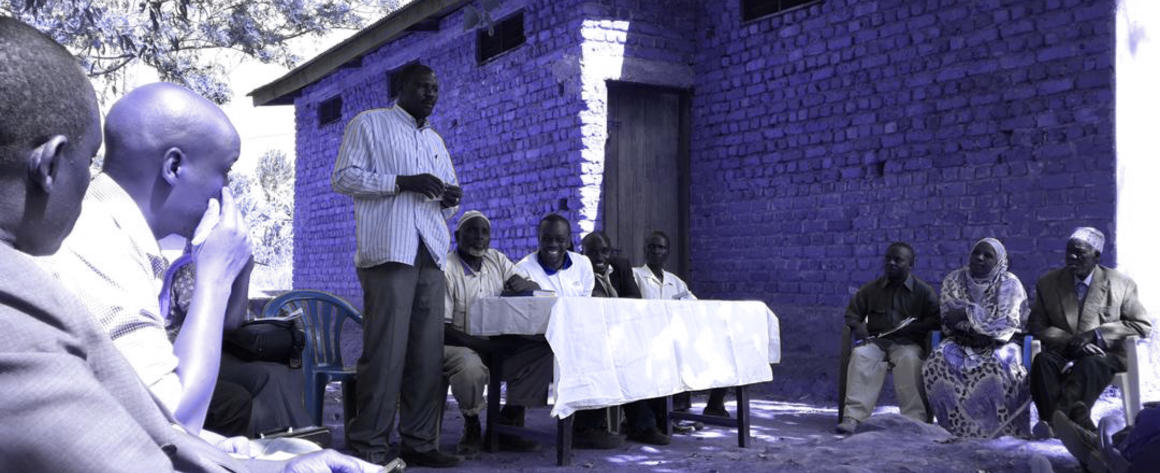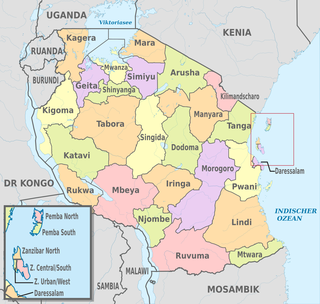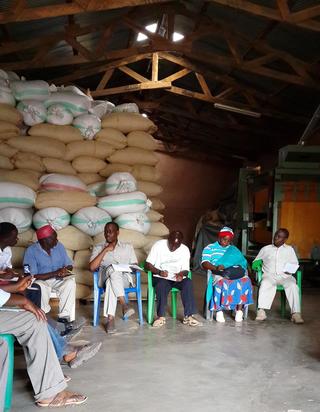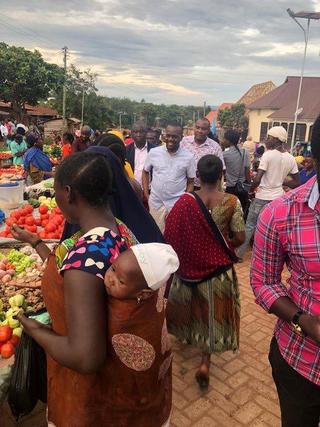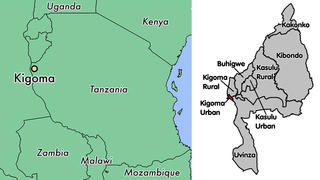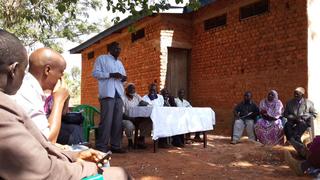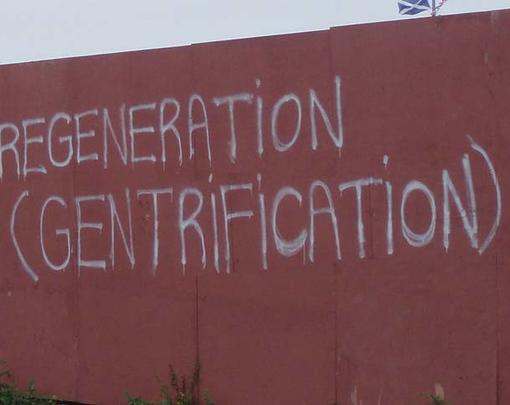Introduction: The Kigoma-Preston Collaboration
Deepening inequality and “jobless growth” are global trends, raising concerns about a dominant economic system that concentrates wealth in relatively few hands.
One response is to advocate tax-and-spend redistribution, a retrospective attempt to correct for an unequal distribution of economic gains. A more ambitious alternative is to address inequality at its source. That means developing institutional mechanisms to ensure broad-based ownership, a form of pre- rather than re-distribution.1
Community wealth building is part of this alternative approach, the idea being to promote more inclusive, community-based forms of economic development. It draws on old ideas, going back to the “Rochdale principles” and the 19 th century roots of the modern cooperative movement. It also takes inspiration from more contemporary successes like the worker-owned Mondragon Corporation in Spain or the cooperative networks in Emilia-Romagna around Bologna. An explicit community wealth building agenda, though, was first popularised in the United States in the mid-2000s and has since spread to the United Kingdom. A key element of this new approach involves working through local government. Cleveland (Ohio) and Preston (Lancashire), for instance, are using local government procurement and support for worker-owned cooperatives to encourage broad-based ownership and living wage jobs. The successes in these cities—notably a more inclusive, dynamic local economy—have inspired calls for a systematic emphasis on community wealth building. In this vein, the UK Labour Party has created a dedicated community wealth building unit under Shadow Chancellor John McDonnell’s office to promote the “Preston model” in cities countrywide.
But interest in this recent experimentation with community wealth building is spreading beyond Anglo-American networks, and indeed, beyond the advanced capitalist economies of the global North. One example of this is an ongoing conversation between advocates of the Preston model in the UK and a group of politicians, activists and academics in Tanzania. This conversation, first started in the wings of the 2018 Labour Party conference,2
now centres on how the Preston experience can inspire similar interventions in Kigoma, a city of some 235,000 in north-western Tanzania.
A majority on the Kigoma town council as well as the area MP are from the opposition party, ACT-Wazalendo. As articulated in the party’s founding declaration, the Tabora Declaration, ACT wants “many people to own parts of the economy through their cooperative unions and associations.” A community wealth building approach thus resonates with the ideas already circulating in Kigoma, and indeed, with a historic Third-Worldist search for alternatives to the binary of capitalism vs. “doctrinaire socialism,” to paraphrase Tanzania’s Independence leader, Julius Nyerere.
A new community wealth building agenda in Kigoma can thus draw on ideas old and new; it can take inspiration from Tanzania’s own history as well as from more recent experiments, including Preston. With this potential for a cross-fertilization of ideas and practical experience, the principal aims of the Kigoma-Preston collaboration are as follows:
(1) To develop a “Kigoma model” of community wealth building – Although a few core principles underpin any community wealth building strategy, the details must be adapted to fit a given local context. They must also be endorsed by the community. The ongoing conversation between Preston and Kigoma is an opportunity to explore what conceptual framework as well as specific institutional mechanisms might work for a “Kigoma model,” bearing in mind the particular opportunities and constraints in Kigoma and, ultimately, the need for a wider discussion about community wealth building in the city itself.
(2) To develop an internationalist approach to promoting community wealth building – Underlying any effort to build community wealth is an effort to build new forms of knowledge, connection and solidarity. That happens within a locality but also across communities and internationally. Equality must be the point of departure for all these relationships. The Kigoma-Preston collaboration is itself rooted in peer-to-peer learning, bringing together local politicians and activists from the two cities and drawing on the current practice, experience and intellectual traditions of both. This two-way exchange can provide a model for further collaborations, yielding practical lessons about how to enact the principles of both internationalism and community wealth building.
(3) To guide the integration of community wealth building into Labour’s overseas development policy – The UK Labour party has committed to creating an economy “for the many, not the few” at home. Echoing this same ambition, its overseas development policy commits to a “world for the many”. At present, though, what that commitment entails still needs further elaboration. The Kigoma-Preston collaboration can help inform how community wealth building—so central to Labour’s domestic economic policy—can be part of its overseas development policy agenda too. The democratic ownership principle, the practical strategies for achieving it, and the internationalist approach—an attempt to circumvent the usual hierarchies associated with “international development”—all offer important lessons for Labour policy.
This introduction outlines the background and ambition of the Kigoma-Preston collaboration. The rest of the paper divides into four parts. First, it reviews Tanzania’s own history of experimenting with democratic ownership, the aim being to draw lessons about the potential and challenges of community wealth building and to situate any future projects in relation to Tanzania’s intellectual tradition and practice. The paper then elaborates on the concept of community wealth building as recently developed in the US and UK, using Preston as a model. Third, it offers a preliminary analysis of the potential for community wealth building in Kigoma, examining what powers the local council can use to drive this agenda. The paper concludes with a more open-ended consideration of how community wealth building can form a part of the Labour Party’s overseas development policy, and more generally, what promoting community wealth building and more bottom-up, democratic ownership internationally may mean.
Part I: A history of community wealth building in Tanzania
Tanzania has its own rich history of experimenting with alternative forms of ownership. A few short years before the country gained independence, nationalist leader Julius Nyerere joined other anti-colonial leaders in calling for “a new synthesis,” an economic system that was neither western Capitalism nor Eastern Bloc Socialism.3 In a 1962 essay, Ujamaa or African Socialism, Nyerere elaborated, stressing the importance of ownership in what would be Tanzania’s alternative economic model. “The basic difference between a socialist society and a capitalist society,” he wrote, “does not lie in their methods of producing wealth, but in the way that wealth is distributed.”4 In the absence of an industrial economy, this idea was the basis for advocating a form of agrarian socialism centred on Ujamaa villages. Nyerere initially stipulated that these villages should be “socialist organizations created by the people and governed by those who lived and work in them.”5 The most successful early villages took inspiration from this message. But over time, what historian Leander Schneider refers to as a “lower-case socialism,” which “had room for flexibility, dispersed authority and players other than the state,” was “replaced by upper-case Socialism” of a centralised and authoritarian bent.6
This section offers a brief overview of this history, focusing in particular on Tanzania’s cooperative movement, how it took root in the colonial period, expanded in the post-Independence era, and was suppressed amidst an authoritarian take-over in the 1970s. Finally, the discussion turns to consider how the cooperative movement has re-emerged—albeit in a more piece-meal form—following the liberalising economic reforms of the 1980s and 1990s. It addresses the potential advantages and weaknesses of this “third generation” of cooperatives, the enduring challenges of negotiating supportive state-cooperative relations, the legacies of structural adjustment, and the role of donors in shaping the space available for cooperative development and democratic ownership. The section concludes with a brief summary of how key themes from Tanzania’s cooperative history can help orient efforts to build cooperatives and community wealth, both in Tanzania and beyond.
Tanzania’s cooperatives, past and present
Cooperative societies were a “European import” to Tanzania and the wider African region; however, from its inception in the 1920s the Tanzanian cooperative movement expanded thanks to the self-organising efforts of African traders and producers.7 The appeal of cooperatives was initially political as much as economic. They were a means for the majority African population to challenge the exploitative terms set by Asian traders, whose commercial dominance was itself a result of colonial efforts to segregate economic activity along racial lines.8 Only in the post-WWII period did the British administration begin to actively support the cooperative movement, which rapidly expanded in cash crop producing regions. The British ambition was both to stimulate cash crop production and to encourage political moderation, the belief being that cooperatives would redirect an emerging nationalist fervour into organising for economic rather than anti-colonial ends.9
This belief proved misguided. Cooperatives played a central role in Tanzania’s nationalist organising, lending their support to the Tanganyika African National Union (TANU), the party that ultimately took over from the British when mainland Tanzania gained its independence in 1961. Cooperatives exercised not only a political but also ideological influence as the TANU leadership declared itself for an “African democratic socialism on the co-operative model.”10
Even before independence, and much more rapidly thereafter, this commitment inspired a push by party activists to create new cooperatives, especially outside their traditional heartland in Tanzania’s cash crop growing regions. In some instances, this effort led to the emergence of genuinely autonomous, member-led and economically successful organisations. While there were other notable ujamaa villages, the key success case was the Ruvuma Development Association (RDA).11
The RDA’s story began in 1960 when 15 TANU Youth League members started a new settlement scheme in the remote south-western region of Ruvuma. The RDA grew slowly, gradually welcoming in new villages. Combining communal and individual plots, these villages became self-sufficient in food, with some producing a surplus for sale. They also invested in schools and water supplies, improved their health and nutrition, and started village industries. The RDA officially registered as a cooperative body in 1965 and was owned and controlled by its member villages, each of which hosted lengthy meetings where villagers could directly influence what decisions were made. The Association also expanded its activities into agricultural processing, using government funds to help purchase a grain mill and sawmill.
The political autonomy and economic success of the RDA were, however, not the norm. The party-led expansion of cooperatives in the early 1960s saw their numbers surge from 857 in 1961 to 1533 in mid-1966. Many of these new organisations were hastily set up by enthusiastic party and local government officials. Largely due to this hurried and top-down approach, they lacked the genuinely democratic quality of the RDA as well as its economic benefits. A divide thus emerged between the older cooperatives in cash crop producing areas, which remained largely autonomous if dominated by “middle class” farmers, and the newly formed ujamaa villages, most of which proved vulnerable to corruption and were principally a creation of Tanzania’s growing party and state officialdom.
Although a 1966 government report cited “political interference” as a major obstacle to cooperative success, party officials pushed for even more ambitious growth and top-down control. A newly empowered cadre of regional party leaders voted to abolish the RDA in 1969, seemingly threatened by this autonomous and politically vocal organisation.12
Meanwhile, the government endorsed a new policy of villagization, the mass resettlement of peasants into collectively farmed villages. This movement, although ostensibly voluntary at first, became compulsory in 1973, resulting in the rapid displacement of about half of Tanzania’s rural population.13
Moreover, in 1976, all remaining cooperatives—such as in the cash crop growing regions—were abolished and replaced by parastatal crop authorities.
These heavy-handed interventions had a devastating effect, both on the livelihoods of the people involved and on Tanzania’s economy as agricultural exports dwindled and economic crisis loomed. Consequently, by the early 1980s, the villagization drive was abandoned, and the government reintroduced cooperatives. Many organisations did quickly re-emerge, but state and party interference continued. Coupled with the adverse economic conditions, these political constraints helped engender the collapse of many newly restored cooperatives.14
This attempted cooperative restoration also coincided with a series of profound economic and political changes. Starting in 1986, the government began implementing liberalising economic reforms backed by the International Monetary Fund and World Bank. Then in 1992, the ruling party—renamed Chama Cha Mapinduzi (Party of the Revolution) in 1977—lifted the ban on opposition parties. CCM nevertheless remained a hegemonic political force, handily winning Tanzania’s first multiparty elections in 1995 and each national election since then.
The anticipated effects of economic liberalization on cooperatives were mixed. On the one hand, many donors hoped that reform of African economies would lead to more autonomous, economically viable cooperatives operating as true private sector enterprises managed by their members.15
On the other hand, some critics, including from the international cooperative movement, were concerned that the shock of structural adjustment would undermine even efficient cooperatives, notably by limiting their access to credit even as they faced increased competition from private traders.16
Ultimately, the impact of liberalization on Tanzania’s cooperatives was “disastrous”; their initial weakness meant that, without time to adjust, they saw private traders quickly take over much of their business.17
The movement thus floundered throughout the 1980s and 1990s. This slump continued even as new laws cut it loose—at least de jure—from government and party control, which had “lowered members’ morale and negatively impacted their attitudes towards cooperatives.”18
During the first half of the 1990s, the overall number of cooperatives fell by more than half, sinking to just over 4000 primary societies in 1994.19
There are now, however, signs of renewal, of a “third generation” of cooperatives. The movement began to pick up from the 2000s with a growing number of cooperatives and cooperative members, whose standard of living tends to surpass that of non-members in the same villages.20
Business volume and overall economic significance remains small compared to the 1950s and 1960s, but in rural areas, cooperatives are “still the most numerous organizations.”21
They also feature prominently in urban areas, with the largest number of cooperatives—if not the highest density, measured relative to total population—in Tanzania’s commercial capital, Dar es Salaam.22
According to official government statistics, the total number of cooperatives in Tanzania by the start of 2018 had reached 10,990 with a total membership of over 2.5 million, or roughly 5.2 percent of the Tanzanian population.23
Some of the most successful examples—such as an association of coffee marketing cooperatives in Kilimanjaro region or the Tanga Dairy Cooperative Union—help support small producers, pool resources to invest in common ventures and pay for community projects like building classrooms or investing in the water supply.24
Some agricultural marketing and processing cooperatives also provide social protection through solidarity funds. Savings and Credit Cooperatives (SACCOs), currently the most widespread form of cooperative, owe much of their success to the social protection they provide members during emergencies.25
There are still notable challenges facing cooperative expansion, not least continued political intervention, bureaucratic obstacles to registration, and lack of adequate state support where needed, particularly assistance with training and access to credit. But the stronger cooperatives and similar, cooperative-like organisations are also taking on these challenges, thereby assuming a more overtly political role. One notable example is MVIWATA, a network of smallholder farmers that now numbers over 400,000 members.26 Its activities, organised through local peasant groups united under a national federation, include lobbying on issues of land redistribution, access to fair markets, agricultural subsidies, credit and infrastructure. These activities illustrate how cooperatives, especially when integrated into strategic networks,27 can become “a platform for collective action to pursue structural change… including changes in power relations.”28 This political contribution is in addition to—and indeed, helps magnify—the more immediate economic and social benefits that individual cooperatives bring to their members and communities. Successful cooperatives push to remould state-cooperative relations, avoiding the co-optation of the past while also demanding a reversal of damaging structural adjustment reforms and, where appropriate, the return of more direct forms of government support.
One final point on the resurgent cooperative movement needs mentioning. That is, the evolving role of donors and, despite its many pitfalls, the importance of external support. Historically, donors have engaged extensively with cooperatives, but often in ways that were not conducive to the consolidation of an autonomous, politically empowered cooperative movement. In the immediate post-colonial period, donors—be they bilateral lenders, the World Bank or other international organisations—largely worked through government institutions, thereby reinforcing existing dynamics of top-down state control.29
Come the period of economic liberalization, organisations like the World Bank and IMF called for a major adjustment in donor engagement; the prescribed new approach involved, one, advocacy for reforms to ensure the withdrawal of the state from the cooperative sector and, two, more direct donor interaction with cooperative organisations “as self-managed, self-supporting, private sector entities.”30
In practice, many organisations—including the World Bank—reduced their involvement with a sector seemingly in decline, shifting instead to support newly emergent non-governmental organisations.31
Critics further stress that—to the extent donor interest in coops has endured—it conforms to a reformist “social enterprise” approach, which involves “an apolitical portrayal of cooperatives as instruments of rural poverty reduction that do not challenge the status quo.”32
This emphasis is limiting in important ways. It does not encourage the integration of the cooperative sector or the development of collective action. It does not inspire the formation, for instance, of strategic networks like MVIWATA interested in pushing for structural change in trade and state-cooperative relations, change that could then allow for a more systematic expansion of democratic ownership and inclusive development.
Despite these shortcomings, there are alternative modes of donor engagement that point towards a more promising approach. This support comes notably through the international cooperative movement itself, structures like the International Cooperative Alliance and cooperative movements from the global north like the Swedish Cooperative Centre and the Canadian Cooperative Association.33 This form of support is not new. Tanzanian cooperatives have historically benefitted from similar international ties. This was true of the Ruvuma Development Association in the 1960s same as it is for numerous successful Tanzanian coops today.34 Using the MVIWATA example again, Martiniello and Nyamsenda (2018) stress the added value of “peer-to-peer” partnership or “movement-to-movement” support. They argue that local MVIWATA groups proved more autonomous and politically vocal where they received initial support from European farmers’ associations. In these instances, “the spirit was to share experiences and learn from one another,” a process facilitated through “exchange visits between these organisations and MVIWATA.” By contrast, where non-government organisations replaced farmers’ associations, or in other cases, where support was delivered through government departments, the attitude of mutual support and learning gave way to a more top-down focus on project delivery as per a largely externally-defined agenda.
Lessons from Tanzania’s cooperative history
Several important themes emerge from the history of Tanzania’s cooperative movement. To summarise briefly, these include the absolute necessity that cooperatives retain their autonomy from the state and ruling party; they must operate as members-led organisations and cultivate the culture of democratic participation and associated governance structures that this entails. Growth of truly members-led organisations is inevitably slow but can nevertheless yield notable social and economic dividends. Available evidence suggests these cooperatives tend to integrate smaller and relatively poor producers rather than privileging just the “middle class”; they are less prone to the corruption that has undermined cooperatives dominated by their top leadership; and they often invest more in diversification of their own economic activities as well as in solidarity funds and community projects.
Emphasising the importance of cooperative autonomy, though, does not mean we can ignore the more complicated facets of State-cooperative relations. In a post-liberalisation era, the narrative of the World Bank and others present cooperatives as “private sector entities” in need of insulation from state intervention. But this depoliticized vision ignores both the adverse impacts of a liberalised policy environment and the value of collective action, namely cooperatives lobbying for fairer market access, credit and the like. Donors, meanwhile, often play a restricted or even damaging role, for instance, by adopting the apolitical and atomising “social enterprise” approach when engaging with cooperatives. But alternative modes of delivering external support, particularly through peer-to-peer engagement across the international cooperative movement, have a better track record when it comes to encouraging autonomous cooperative organisation as well as the integration of politically empowered cooperative networks.
What does all this mean, though, when it comes to thinking about community wealth building in Tanzania today? Or about the role of external actors in supporting it? Is there something to be learned from recent experiences of local interventions in the global North? In Preston? Tanzania clearly has its own history of democratic ownership, from which it is necessary to learn before any further action is taken. This history, moreover, indicates that the localised success of cooperatives and other experiments in democratic control of the economy very much depends on the national power balance, on the relationship with the state and wider economic policy regime. Intervening directly at national level can be politically challenging, though, and not always the most effective means of developing and implementing new ideas. As such, there is room to explore whether and how local councils can serve as a vehicle for supporting cooperatives and, more generally, advancing a community wealth building agenda. Just as the Labour-controlled Preston Council has developed and popularised its own “model,” all while operating under austerity conditions imposed by a Conservative-led UK government, there may be room for Tanzanian local councils to do the same. There is precedent for this. The villages of the Ruvuma Development Association certainly left their mark, influencing—albeit briefly—the policy orientation of the 1960s Tanzanian government. The foregoing discussion explores these possibilities further, reviewing the Preston model, considering prospects for a “Kigoma model,” and concluding with a reflection on what approach donors could take to support these initiatives, both at the local level and through advocacy for policy change nationally.
Part II: Community wealth building and the “Preston model”
Drawing on recent experiences from the US and UK, this section briefly introduces some of the main drivers of community wealth building; that is, it reviews what practical measures can help create local wealth and ensure it is more democratically controlled and equally distributed. It then examines how these measures are pursued in practice, looking at specific local government initiatives adopted to promote the broader community wealth building agenda. We look, first, at the case of Preston in Lancashire and then, in the next section, extend this analysis to the city of Kigoma in Tanzania.35
Drivers of community wealth building
Among the key drivers of community wealth building is the promotion of local ownership and good quality jobs through support for cooperatives. Community wealth building strategies, however, go beyond cooperative ownership alone. Particularly when pursued with the support of local government, the effort can include—although it is not restricted to—the following approaches:36
Municipal ownership – Local governments have pursued municipal ownership as a means of concentrating investment locally and ensuring social and environmental value in addition to desired economic gains.
Progressive procurement – A more strategic use of local government procurement budgets, as well as budgets of key “anchor institutions,” can also contribute to local wealth. This involves local government, alongside other big-spending institutions like hospitals and universities, redirecting their procurement budgets to buy from local businesses and cooperatives. Money thus keeps circulating in the local economy, creating a valuable multiplier effect and providing much needed support to local and more democratic forms of ownership.
Community-linked hiring strategy – As part of a progressive procurement approach, local government and anchor institutions can require that contractors hire workers locally and pay a living wage, among other measures to support quality local jobs.
Local asset management – Beyond their procurement budgets, local government and key “anchors” can also make certain existing assets available for community use, for instance, by offering properties at low rent to incubate new cooperatives businesses.
Community ownership strategies – Beyond assets owned by local government or anchors, the promoting of community ownership through, for instance, the creation of community land trusts can help keep homes affordable amidst a general trend towards gentrification and rising real estate prices.
Alternative finance – Cooperative and city-owned banks can provide additional financial support to further advance a broad community wealth building agenda. Similarly, public pension funds can redirect their investments to prioritise local projects, substituting the more standard emphasis on equity owned by shareholders in other regions or overseas.
Inclusive decision-making – Inclusion, “the opening up of economic opportunity and voice to previously excluded social groups,” can be achieved through, for instance, more participatory budgeting, creating new channels for city residents to influence local government budget and development plans.
The above drivers may seem fragmentary. When combined, though, these point towards a more thoroughgoing re-orientation of how the local economy is managed and for whom. They can help support a “new system,” not unlike the “new synthesis” advocated by Tanzania’s founding President, Julius Nyerere. The status quo leads to wealth owned by a narrow economic elite, allows for money to exit the local economy, and limits the extent of genuine democracy. By contrast, a community wealth building approach entails a more strategic use of available assets to promote broad-based ownership, greater political participation, and a more dynamic local economy.
The “Preston model”
Preston was in many ways a prime candidate to embrace community wealth building. A once prosperous industrial town, it has seen its wealth ebb away amidst the general decline in British manufacturing. The city was then hit hard by the post-2008 recession. After Cameron’s coalition government began implementing austerity in 2010, the Preston council saw half its government grants cut in just three years, emerging as one of the 10 worst-affected local authorities. With private investment drying up as well, Preston was desperately in need of a new economic approach.
But from a crisis comes an opportunity. As observed by the current Preston council leader and long-time community wealth building champion, Matthew Brown, the economic crash meant that “new ideas became a lot more appealing to people.”37 In 2011, Brown was a freshly appointed cabinet member in Preston’s Labour-controlled council. He set about exploring what alternative strategies could help revive Preston’s economy, drawing inspiration from several experiments in community wealth building elsewhere. This included work done by the Democracy Collaborative think-tank along with partners in Cleveland, Ohio. Another post-industrial town, Cleveland invested in worker-owned cooperatives, which became economically viable once local “anchor” institutions—including a large hospital—agreed to buy services from them.
Preston’s own community wealth building efforts now encompass a range of initiatives, many in line with the above-enumerated drivers:38
Supporting the living wage – In an effort to prop up stagnating salaries, Preston Council declared itself the first living wage employer in the north of England in 2012. The council thereby committed to pay its own staff plus compel all contractors to pay their employees an hourly wage significantly higher than the statutory minimum.
A new procurement strategy – At the heart of the Preston model is a collaborative approach to progressive procurement, involving several key anchor institutions. To begin with, these anchors include the Preston city and Lancashire county councils, a police force, two colleges and the city’s largest social housing association. Collectively, they agreed to abide by certain principles of progressive procurement, including making it easier for local organisations to bid for contracts, buying more form local providers whenever possible, and identifying services that could be provided by worker-owned cooperatives. In the first two years of operating this new procurement strategy, the anchors together redirected an estimated £4 million into the Preston economy, money that otherwise would have left the local area.
Growing cooperatives – Whereas it was relatively easy for Preston to pursue a new procurement strategy, building cooperatives has proved a more long-term ambition. Cleveland’s above-mentioned success in this domain was thanks, in part, to the availability of start-up funding from local philanthropic foundations. Preston lacked this support. It has nevertheless encouraged the creation of a credit union and has expanded an initiative to house cooperatives in unused council properties, among other strategies to support networks of existing cooperatives as well as the incubation of new ones.
The Larder Café, located opposite town hall in Preston’s busy retail centre, is an example of one such new cooperative. Worker-owned, the Larder rents its premises at a cut rate from the local council. It is currently in the process of expanding its locally sourced supply chain, comprised of small farm and catering businesses from across Lancashire. The aim is for these suppliers eventually to form their own association or marketing cooperative and sell to the larger anchor institutions already supporting the Preston Model.
Reinvesting pension funds – Reinvesting the more than £5.5 billion, the Lancashire Pension Fund is another promising strategy, particularly as much of this money is invested in overseas equities that often fail to yield the desired returns. The council is involved in efforts to instead invest more of the pension fund in the local economy and with an emphasis on social value. For instance, the pension fund is investing £18 million in the redevelopment of Preston’s historic Park Hotel. Whereas 15 years ago, 73 percent of the pension fund was invested in equity, mostly overseas, that figure has now gone down to 42.5. There are more plans to invest an additional £100 million in the local area, with Preston Council working to ensure more of that goes into affordable housing.
Community Banking – Preston Council is currently coordinating with other actors across Lancashire to found Northwest, a customer-owned cooperative bank. This effort is being pursued in collaboration with the Community Savings Bank Association.39 Established in 2015, CSBA aims to help set up a network of 18 regional co-operative banks across the UK. According to the cooperative principle, the banks will be controlled by their customer-members, each of whom will have one vote. The purpose of this cooperative banking model is to make banking services, and especially loans, more readily available to those most often excluded—small and medium enterprise, community groups and households of ordinary means.40
The above measures pursued by Preston Council, in close collaboration with local partners, have already helped re-energise the local economy. In 2018, the accountancy firm PricewaterhouseCoopers declared Preston the most rapidly improving urban area in the UK to live and work.41 Preston’s community wealth building efforts nevertheless continue, the council having set its ambitions high. “I think we’ve got to move beyond capitalism to a new system,” Matthew Brown affirmed in a recent interview.42 “It’s not going to be the state running everything,” he clarified, adding, “It’s going to be a devolved economy, a democratic economy, using all these different mechanisms and institutions to localize wealth.”
In sum, community wealth building is a broad concept, the overarching aim being to transform the economic status quo, privileging a more localized and equitable distribution of wealth. As Matthew Brown notes, actually building community wealth means using a variety of strategies. These must be adapted to suit a given context as per the resources available. What worked in Cleveland did not work—at least not initially—in Preston. What then if we adapt this “next system” approach to a still more contrasting context? What form of community wealth building might work in a Tanzanian town?
Part III: Towards a “Kigoma Model”
The city of Kigoma is situated in what should be a prime geographic location. It abuts Tanzania’s north-western border with Burundi and the Democratic Republic of Congo and sits along the shores of Lake Tanganyika. Despite its potential to serve as an international transport hub, Kigoma has remained economically marginalised. Never a major cash crop growing area in the colonial period, it has not been a priority for state-led development efforts thereafter either. It was only recently connected to Tanzania’s transport network following the construction of a new tarmacked road. Still, private investment has proved slow to arrive while the city’s population of roughly 235,000 continues to expand by over two percent annually.43
A change did come in 2015, however, at least at the political level. While the ruling party again won the national parliamentary and presidential elections, an opposition party, ACT-Wazalendo, took control of the Kigoma town council. The area MP, Zitto Kabwe, is also the party leader and co-founder. ACT is committed ideologically to a form of “Democratic Socialism,” to be realised through a range of mechanisms including building cooperatives. Since taking power, the party has tried to pursue its agenda in Kigoma, albeit with some difficulty.
This section first reviews some of the general constraints facing local authorities in Tanzania. It then outlines how the Kigoma town council has sought to surmount these challenges, highlighting its efforts to redirect local resources towards a form of community wealth building. Finally, it considers what a “Kigoma model” could mean for the rest of Tanzania.
Local government in Tanzania
The fortunes of a democratic model of local government in Tanzania have tracked the vagaries of the country’s cooperative movement. In the immediate post-Independence years, the expansion of elected local authorities at district level was encouraged, in part because they were thought to encourage citizens’ participation and “self-reliance”.44 By the early 1970s, though, elected local councils were abolished, replaced by unelected administrative bodies staffed by the central government. Poor accountability and spiraling costs, however, meant that by the early 1980s, the government revived local councils, although it still retained considerable control.45
The current system of local government has “multiple and contested lines of power.”46 While district councillors are elected directly at ward level, most of the administrative staff is still appointed centrally. Local governments also have limited fiscal autonomy; the majority lack significant revenue generating capacity, meaning they rely on transfers from central government for most of their expenditure. This spending is then overseen by centrally appointed administrators, who exercise considerable influence in how certain funds are spent. That said, elected councils do have some authority to dictate budgets and, where they benefit from a stronger local revenue base, exercise significant autonomy over own-source expenditure.47
Since the 2015 elections, however, local authorities across Tanzania have had to contend with new austerity conditions. Although CCM has retained power since independence, it has institutionalised presidential term limits since 1985 and, in 2015, a new CCM President, John Pombe Magufuli, took over. Magufuli has since manoeuvred to cut expenditure and centralise fiscal control—both through formal and informal means.48 For instance, important sources of local revenue—including property tax and advertising revenue from billboards—are now collected by the centrally administered Tanzania Revenue Authority and, counter to earlier promises, not transferred back to local authorities. Central government has also failed to implement agreed budget plans, simply withholding funds earmarked for local government expenditure.
Ultimately, this austerity politics means that many areas with limited inward investment are seeing even less money enter and circulate through the local economy. Meanwhile, district councils keen to exercise some degree of autonomy have a powerful incentive to find new ways of making what resources they have bear fruit.
Community wealth building against the odds
Much like Preston, economically marginalised and hard-hit by government cuts, Kigoma has every reason to try an alternative strategy of community wealth building, as do many other local areas across Tanzania. The ACT-controlled city council has already proposed some interventions consistent with a community wealth building approach, although there are still other mechanisms for delivering inclusive development that it has yet to explore. A range of ideas are considered below:49
A new procurement strategy – The idea of a Preston-style progressive procurement strategy, coordinated with local “anchor institutions,” is new to Kigoma. There are some notable potential obstacles. While a base-line study of procurement spending would help confirm this assessment, ACT officials judge that would-be anchor institutions have limited resources or scope to redirect spending. The Kigoma council could pursue a more modest strategy on its own. This would involve using funds from local revenue collection, over which the council has more direct influence. Before the recent centralisation of important revenue-generating powers, the council collected over Sh2 billion (USD 1m) locally per year. That amount has since fallen by half, with the council collecting only Sh1.2 billion in the 2017-2018 financial year. Although much reduced, this is not an insignificant sum. The council still uses its locally sourced revenue to procure a range of goods and services, for instance, school textbooks and other supplies. It could, therefore, revisit how it awards these procurement contracts and, notably, support the creation of and/or prioritise existing cooperatively owned suppliers.
Building and supporting cooperatives – Growing cooperatives is perhaps the aspect of community wealth building that ACT and the Kigoma council have emphasised most in their own development plans. Beyond Kigoma town, the wider Kigoma region is not among those where the cooperative movement is strongest. In 2018, the region had 411 cooperatives with a total membership of 62,423, or 2.6 percent of the total population. This is well below the national average of 5.2 percent and a fraction of the over 13 percent of the population who are cooperative members in Kilimanjaro region, the historical heartland of the movement.
Despite Kigoma starting from a low base, there is still considerable potential to grow and diversify cooperatives, including in and around Kigoma town. While most Kigoma cooperatives are SACCOs, the region also features over 100 agricultural marketing and processing cooperatives, as well as cooperatives in a range of other industries from livestock and bee keeping to fisheries. ACT has identified economic activities that could be a focus of cooperative expansion and thereby generate more inclusive development. These include strengthening existing coffee cooperatives plus organising cooperatives in new sectors, such as rice-growing in the fertile Luiche river delta, located within Kigoma municipality, as well as fishing, oil palm cultivation and palm oil processing.
Cooperatives focused on coffee production and marketing are among the strongest in Kigoma region. These cooperatives comprise smaller primary societies, which then come together to form a larger cooperative union, Kanyovu. The union has 11,000 members in the region and a turnover of 850 tonnes of coffee per annum. Among the challenges the primary societies face is access to finance and training of cooperative managers. These are areas where ACT is interested in coordinating support, targeting both the peri-urban coffee-growing areas of Kigoma municipality (Kigoma Urban on the map) and nearby rural districts, including Kigoma Rural, where it has a significant presence and ties to the local primary society, Rumaku.
ACT has already, through the Kigoma Council, pursued plans for rice-growing in the Luiche Delta, the aim being to support cooperatively managed smallholder production and invest in processing. With the help of a loan from the Kuwait Government to develop irrigation infrastructure, the council hoped to make 3000 ha of irrigated farmland plots available to be allocated to 3000 households. These smallholders would all be members of their own Outgrower Cooperatives, which would then supply a processing plant to dry, mill and package rice grown in the delta.
Unfortunately, the loan from Kuwait ultimately fell through as it needed the approval of the Minister of Finance, who refused to sign off on it. This outcome suggests the need to find alternative means of encouraging more modest cooperative expansion, and with alternative forms of external support less dependent on central government approval. Not unlike Preston council, the Kigoma council can potentially begin by encouraging more networking and mutual support across existing cooperatives while facilitating training and directing external assistance towards promising new projects.
This effort could also involve looking beyond the current focus on agricultural activities. With the growing volume of road transport passing through Kigoma, the transport and logistics sector could be an important target for cooperative expansion. There is currently a relatively small number of transport-related cooperatives in Tanzania, only 24 registered in 2018, but a notable appetite for growth. For instance, a union of commercial bus drivers based in Dar es Salaam is currently organising to form its own worker-owned cooperative to bypass exploitative private companies.50
This is an initiative that Kigoma-based drivers could emulate.
The Kigoma City council has also supported women market vendors, using Danish funding to help set up a solar-powered night market. The market is located along a newly paved street, which also features additional toilet and water facilities. Following encouragement from councillors, the venders formed an association, elected their leaders and advocated for their priority investments, such as construction of the new toilets. There is still a need for further improvements to the market, though, such as the addition of storage and refrigeration facilities. There is also scope for more mutual support and cooperative organising. In addition to their association, which is primarily a platform for collective advocacy, the venders could form SACCOs or some other cooperative arrangement to pool resources and amplify their shared economic benefit.
Whatever the exact focus or modality for building cooperatives, it remains a worthwhile area for Kigoma council to concentrate its attention. There may even be a benefit in beginning with smaller initiatives, despite the notable promise of the Luiche Delta investment. The council can start slow, working from the grassroots to help foster a democratic culture and members-led model of cooperative organisation. It is, after all, this gradual approach that has historically proved most beneficial in Tanzania and that, above all, requires a strong commitment to cultivating collective education and participatory decision-making.
Pensions and Social Security – ACT has explored an additional community wealth building strategy centred on a new social security scheme. The central aim is to ensure that social security and pension schemes are extended to include smaller producers and informal sector workers, all while reinvesting these funds in community projects and cooperatives. One idea was to encourage members of the Outgrowers Cooperative linked to the Luiche Delta project to contribute to a social security or solidarity fund, which would then be used to help cover the cost of health and other emergencies. While promising, these plans for building community wealth through pensions and insurance schemes are an area for further research and development.
In sum, although Kigoma municipality faces a set of steep challenges, there is still considerable room for more creative thinking about how to use council resources. Like other local authorities, it is looking to counter adverse conditions with a new approach to community wealth building.
A “Kigoma model” for Tanzania
If Kigoma town council develops its capacity to facilitate local cooperative expansion, alongside other community wealth building strategies, it can serve as a model to under-resourced local authorities elsewhere in Tanzania. Additional means of pursuing more inclusive development may also be explored. This includes, for instance, in the often fraught domain of land management, although under the current legislative regime local government has limited effective power in this area.51 Whatever the means, refocusing attention on local interventions and more democratic ownership is an urgent agenda in a country where, despite growth averaging six percent since the 2000s, poverty rates have remained stubbornly high.52 Moving ahead with a community wealth building agenda will nevertheless require both committed local leadership and, given resource constraints, would also benefit from more external support, a possibility discussed further in the conclusion to this paper.
Conclusion: A world for the many
The search continues for a “new system,” a “new synthesis” whereby wealth is spread more equally and subjected to democratic control. Community wealth building is part of this wider search. Experiments in using local authorities have already demonstrated what this agenda can achieve in a post-industrial British town. There is now scope for the lessons from this success to inform similar efforts, not only in the global North but the South too. Kigoma is one place where there is already interest in using local government to build community wealth. The Kigoma-Preston collaboration is about encouraging this effort through shared experience and exchange. Ideally, this will then give rise to a “Kigoma model,” which may inspire others in Tanzania and further afield.
The conversation around the Kigoma-Preston collaboration also has useful lessons to offer back in the UK, not least for the Labour Party and its overseas development policy. Underpinning this policy is the idea of a “world for the many,” a more egalitarian distribution of wealth and power globally.53 This includes, to quote Shadow Chancellor John McDonnell, “reshaping the international settlement,” making it “less top-down.”54 Somewhat more modestly, it also means undercutting the hierarchical relations traditionally associated with North-to-South “overseas development assistance”.
The exchange between Kigoma and Preston, and the Tanzanian experience of democratic ownership generally, can help inform this broader agenda in at least three ways:
Spreading community wealth building – Many of the same local government strategies used to build community wealth in the global North can also work to address inequalities in low income countries of the global South. From Preston to Kigoma, progressive procurement, support for cooperatives, improved community asset management and the like can help ensure more localised growth and inclusive development. Each experiment in community wealth building must be moulded to suit its specific context and, inevitably, generates new lessons in the process. But all these efforts fit within a common framework, which can be used to guide community wealth building both in the UK and abroad.
Peer-to-peer, movement-to-movement support – Efforts to integrate community wealth building into UK overseas development policy must consider the mode of delivery and, notably, the value of horizontal, peer-to-peer partnerships like the one between Kigoma and Preston. Links between ACT officials and councillors from Preston emerged organically out of an initial encounter involving the Kigoma MP, Zitto Kabwe, and The Democracy Collaborative, a Preston-supporting think-tank. This fortuitous meeting has now sparked a dialogue between the Kigoma and Preston local authorities, which is characterised by its own spirit of exchange and mutual learning. Going forward, there is every reason to continue spreading a community wealth building agenda through this form of partnership, as in by exploring additional ways of connecting local authorities. This could involve, for instance, additional funding and policy support for twinning arrangements between cities in the UK and abroad.
The UK can also expand this approach to go beyond the focus on local government as a vehicle for building community wealth; as in, it can develop new, egalitarian mechanisms to support democratic ownership more generally, including by supporting mutual exchange between cooperatives and trade unions.
There are many examples of this kind of activity. As emphasised in the earlier discussion of Tanzania’s cooperative history, support from the international cooperative movement has played an important role in Tanzania’s own cooperative development. More recently, under Gordon Brown’s Labour government, the Department for International Development (DfID) funded efforts to expand this movement-to-movement support through a project led by the International Labour Organisation (ILO). The ILO initiative collapsed, however, once David Cameron’s coalition government withdrew funding.55
In contrast to DfID’s more sporadic efforts, the Swedish International Development Agency (SIDA) has consistently supported international collaborations between cooperatives and trade unions, among other organisations.56
For instance, it partners with the organisation Union to Union, which helps coordinate several Swedish trade unions engaged in international trade union development.57
This work involves everything from specific labour rights campaigns to the nuts-and-bolts of union organising. For instance, a Swedish Metalworkers Union (IF Metall) successfully partnered with a Zambian miners’ union trying to rebuild after a change in mine ownership resulted it the retrenchment of a large portion of its membership.58
Ultimately, this horizontal approach is desirable both in principle, given that it privileges more horizontal power relations, and in practice as it offers an effective means to strengthen the organisations most central to ensuring inclusive development.
Scaling up – While there is clearly value in focusing on local interventions and on strengthening organisations like coops and trade unions, a community wealth building agenda cannot lose sight of the wider policy environment nor of the role national governments play in shaping opportunities for inclusive development. As noted earlier, the work of councils like Preston and Kigoma offer models, which can then inspire other councils to follow suit plus motivate national policy changes to facilitate this emulation. In the Tanzanian case, for instance, legislative reforms to increase the fiscal autonomy of local councils are one potentially valuable—if, at present, politically unlikely—strategy to enable more effective community wealth building. More broadly, the earlier discussion of Tanzania’s cooperative movement indicates the need to explore ways of ensuring supportive policy in that area. This includes reversing aspects of structural adjustment reform, which have limited cooperatives’ access to finance and created liberalised trade conditions that often favour large multinational investors over cooperative enterprise. It follows that any effort to include support for community wealth building and broader democratic ownership in UK overseas development policy must combine more localised interventions with support for policy discussion and advocacy, ideally by facilitating the collective action and lobbying efforts of cooperatives themselves.
This paper began with three objectives: to begin defining what a “Kigoma model” might entail, drawing on the Preston experience; to explore more egalitarian, “internationalist” mechanisms for engaging in overseas development assistance; and to inform the UK’s overseas development approach, particularly emphasising the value of including support for democratic ownership within the Labour Party’s development policy. The Kigoma-Preston collaboration is itself ongoing, and although promising, much work remains to be done to build a “Kigoma model”. But through this experiment, valuable in its own right, we can begin imagining a more ambitious agenda of spreading community wealth and democratic ownership globally.
- 1M. O’Neill and T. Williamson, “The promise of pre-distribution,” Policy Network, 2012.
- 2Z Kabwe, “Realising Economic Justice in Tanzania: An interview with Zitto Kabwe,” Renewal, 2018.
- 3J. Nyerere, “Groping Forward,” in Freedom and Unity: A selection from writings and speeches, 1952-65, London: Oxford University Press, 1966.
A. Getachew, “When Jamaica Led the Postcolonial Fight Against Exploitation,” Boston Review, 5 February 2019. Accessed 22 July 2019: http://bostonreview.net/race/adom-getachew-when-jamaica-led-postcolonial-fight-against-exploitation
- 4J. Nyerere, “Ujamaa – The Basis of African Socialism”. Accessed 23 May 2019: http://www.jpanafrican.org/edocs/e-DocUjamma3.5.pdf
- 5Cited in L. Schneider, “Liberating development? Rule and liberation in post-independence Tanzania,” Journal of Contemporary African Studies, 32:3, 2014.
- 6Schneider, 2014.
- 7O. van Cranenburgh, The Widening gyre: The Tanzanian one-party state and policy towards rural cooperatives, Delft: Eburon, 1990: 122.
There were important forms of mutuality and cooperative labour that predated colonial conquest, and indeed survived it, but these organisational forms are distinct from the more formal, legally recognised forms of cooperative enterprise that first surfaced under colonial rule. For more background, see:
S. Nyanchoga, “Mutualism and Cooperative Work,” in eds. S. Bellucci and A. Eckert, General Labour History of Africa, Suffolk: James Curry, 2019.
- 8I. Shivji, Class struggles in Tanzania, London: Heinemann Educational, 1976.
- 9P. Kelemen, “Modernising colonialism: The British Labour movement and Africa,” Journal of Imperial and Commonwealth History, 34:2.
- 10J. Iliffe, A Modern History of Tanganyika, Cambridge: Cambridge University Press, 1979: 575.
- 11For a detailed discussion of the RDA, see:A. Coulson, Tanzania: A political economy, Oxford: Clarendon Press, 1982: Chapter 22, appendix 1.
- 12Ibid.
- 13C. Boone and L. Nyeme, “Land institutions and political ethnicity in Africa: Evidence form Tanzania,” Comparative Politics, 48(1), 2015: 71.
- 14S. Maghimbi, “Cooperatives in Tanzania mainland: Revival and growth,” Coop Working Paper No. 14, 2010: 9-10.
- 15P. Hussi, J. Murphy, O. Lindberg and L. Brenneman, “The Development of Cooperatives and Other Rural Organizations: The Role of the World Bank,” World Bank Technical Paper Number 199, 1993.
- 16P. Develtere, “Cooperative development in Africa up to the 1990s,” in eds. P Develtere, I. Pollet and F. Wanyama, Cooperative out of Poverty: the Renaissance of the African Cooperative Movement, Geneva: International Labour Organisation: 24.
- 17J. Birchall and R. Simmons, “The co-operative reform process in Tanzania and Sri Lanka,” Annals of Public and Cooperative Economics, 81(3), 2010: 479.
- 18Maghimbi: 9-10.
- 19J. Birchall and R. Simmons, 479. S. Mushi, Development and democratisation in Tanzania: A study of rural grassroots politics, Kampala: Fountain Publications, 2001.
- 20Maghimbi, 2010.
- 21Ibid: 28.
- 22Tanzania Cooperative Development Commission (TCDC), official statistics on cooperative number and membership, 31 December 2017. Accessed 23 May 2019: https://www.ushirika.go.tz/statistics/
- 23TCDC: https://www.ushirika.go.tz/statistics/
- 24Maghimbi: 27-31.
- 25Ibid: 28.
- 26G. Martiniello and S. Nyamsenda, “Agrarian Movements in the Neoliberal Era: The Case of MVIWATA in Tanzania,” Agrarian South: Journal of Political Economy, 7(2), 2018: 151. See also Birchall and Simmons: 479.
- 27P. Develtere and I. Pollet, “Renaissance of African Cooperatives in the 21st Century: Lessons from the Field,” in eds. P Develtere, I. Pollet and F. Wanyama, Cooperative out of Poverty: the Renaissance of the African Cooperative Movement, Geneva: International Labour Organisation: 46-8.
- 28K. Wedig and J. Wiegratz, “Neoliberalism and the revival of agricultural cooperatives: The case of the coffee sector in Uganda,” Journal of Agrarian Change, 18, 2018: 353.
- 29Hussi et al.; Develtere; Wedig and Wiegratz.
- 30Hussi et al.; van Cranenburgh.
- 31Develtere; Develtere and Pollet.
- 32Wedig and Wiegratz: 353.
- 33Develtere and Pollet: 70.
- 34Maghimbi.
- 35Although the focus here is on community wealth building in towns, rural areas can also pursue a similar agenda. For instance, see: S. Gutierrez, “An Indigenous approach to community wealth building: A Lakota translation,” Democracy Collaborative, 2018.
- 36This summary draws principally on: M. Kelly and S. McKinley, “Cities building community wealth,” Democracy Collaborative, 2015.
- 37M. O’Neill interviews M. Brown, “The Road to socialism is the A59: The Preston Model,” Renewal, 2016.
- 38This section draws on discussions with Michael Brown during a tour of Preston in May 2019 as well as the following accounts:
A. Chakrabortty, “In 2011 Preston hit rock bottom. Then it took back control,” The Guardian, 31 Jan 2018: https://www.theguardian.com/commentisfree/2018/jan/31/preston-hit-rock-bottom-took-back-control
H. Sheffield, “The Preston model: UK takes lessons in recovery from rust-belt Cleveland,” The Guardian, 11 April 2017: https://www.theguardian.com/cities/2017/apr/11/preston-cleveland-model-lessons-recovery-rust-belt
C. Singer, “The Preston Model,” The Next System Project, 9 Sept 2016: https://thenextsystem.org/the-preston-model
- 39Accessed 3 July 2019: https://www.csba.co.uk/
- 40For more background, see: Tony Greenham, “Everyone a Banker? Welcome to the New Co-operative Banking Movement,” The RSA, 30 June 2017:
https://www.thersa.org/discover/publications-and-articles/rsa-blogs/2017/06/everyone-a-banker-welcome-to-the-new-co-operative-banking-movement
- 41R. Partington, “Preston named as most improved city in UK,” The Guardian, 1 Nov 2018: https://www.theguardian.com/politics/2018/nov/01/preston-named-as-most-most-improved-city-in-uk
- 42M. O’Neill interview with M. Brown.
- 43M. Pangani, “Maelezo ya mkurugenzi wa manispaa ya Kigoma/Ujiji Ndugu Mwailwa Pangani, kwa kamati ya bunge ya tawala za mikoa na serikali za mitaa kuhusu utekelezaji wa bajeti yam waka 2017/18, 2018/2019 na Makadirio yam waka 2019/2020”: page 2.
- 44A. Eckert, “Useful instruments of participation? Local government and cooperatives in Tanzania, 1940s to 1970s,” The International Journal of African Historical Studies, 40(1), 2007.
- 45B. Hoffman, Political accountability at the local level in Tanzania, Thesis, UC San Diego, 2006.
- 46A. Mdee and L. Thorley, “Good governance, local government, accountability and service delivery in Tanzania: Exploring the context for creating a local governance performance index,” Working Paper 2, Mzumbe University, 2016: 5.
- 47Mdee and Thorley; Hoffman.
- 48On the centralisation of control over property tax, see: O-H Fjeldstad, M Ali, and Lucas Katera, “Taxing the urban boom in Tanzania: Central versus local government property tax collection,” CMI: CMI Insight No. 3, 2017: https://www.cmi.no/publications/file/6260-taxing-the-urban-boom-in-tanzania.pdf
- 49The below discussion draws on a range of local government documents, mostly in Swahili, and discussion with ACT officials.
- 50Abdallah Lubala, “Bus politics in Dar es Salaam,” Africa is a Country, 2019: https://africasacountry.com/2019/01/the-only-way-to-eliminate-exploitation-from-the-transport-sector
- 51G. Sundet, “The 1999 Land Act and Village Land Act: A technical analysis of the practical implications of the Acts,” draft paper. Accessed 29 July 2019: http://mokoro.co.uk/wp-content/uploads/1999_land_act_and_village_land_act_tanzania.pdf
- 52On the failure to reduce entrenched poverty levels, see: H. Gray, Turbulence and order in economic development: Institutions and economic transformation in Tanzania and Vietnam, Oxford: Oxford University Press, 2018, Chapter 1.
- 53Kate Osamor MP, “A World for the Many, Not the Few: The Labour Party’s Vision for International Development,” policy paper, March 2018. Accessed 23 May 2019: https://www.policyforum.labour.org.uk/uploads/editor/files/World_For_The_Many.pdf
- 54Speech delivered at Labour’s International Social Forum, 13-14 July 2019.
- 55J. Schwettmann (ILO), “Cooperatives in Africa: Success and Challenges,” a contribution to the International Symposium on Cooperatives and Sustainable Development Goals: The Case of Africa, Berlin, 2 September 2014.
- 56Accessed 23 May 2019: https://www.sida.se/English/how-we-work/approaches-and-methods/
- 57Accessed 23 May 2019: https://www.uniontounion.org/
- 58Accessed 23 May 2019: https://www.uniontounion.org/malet-ar-att-starka-facket-i-afrika

